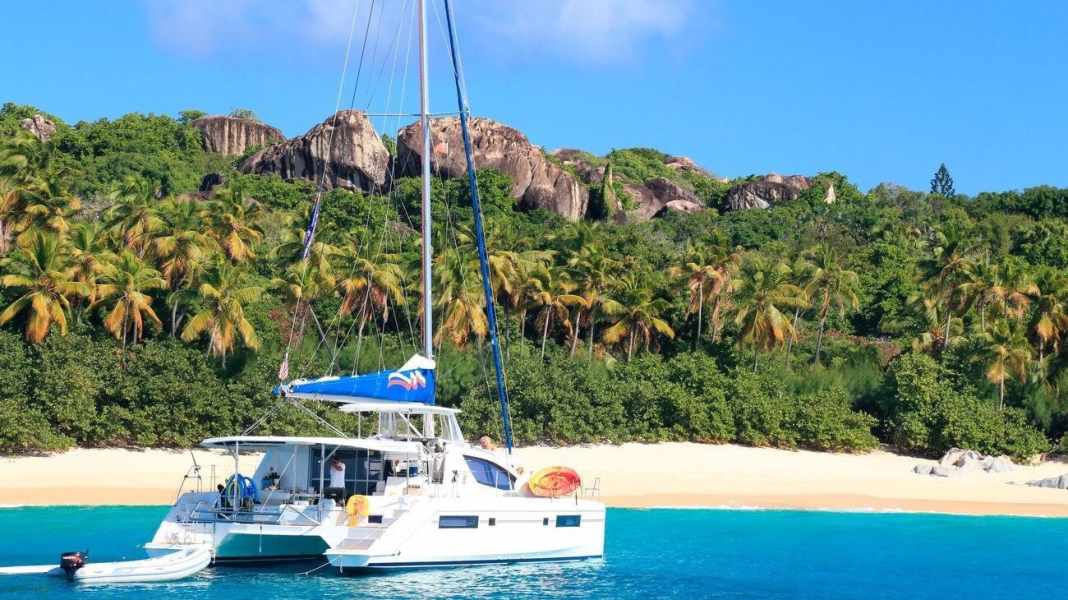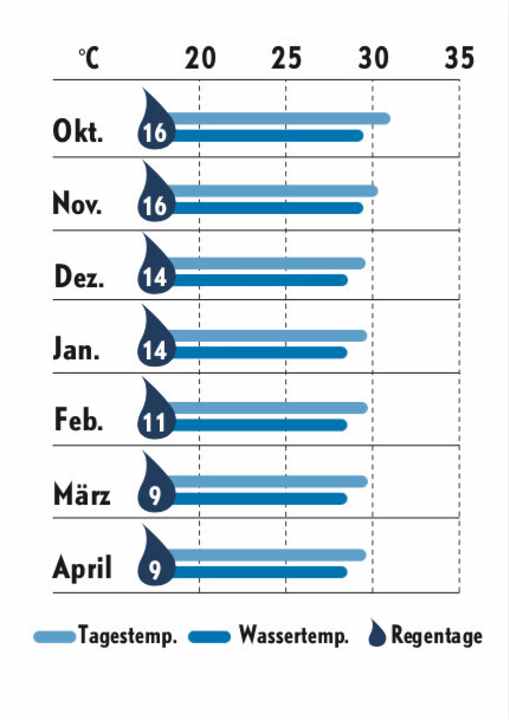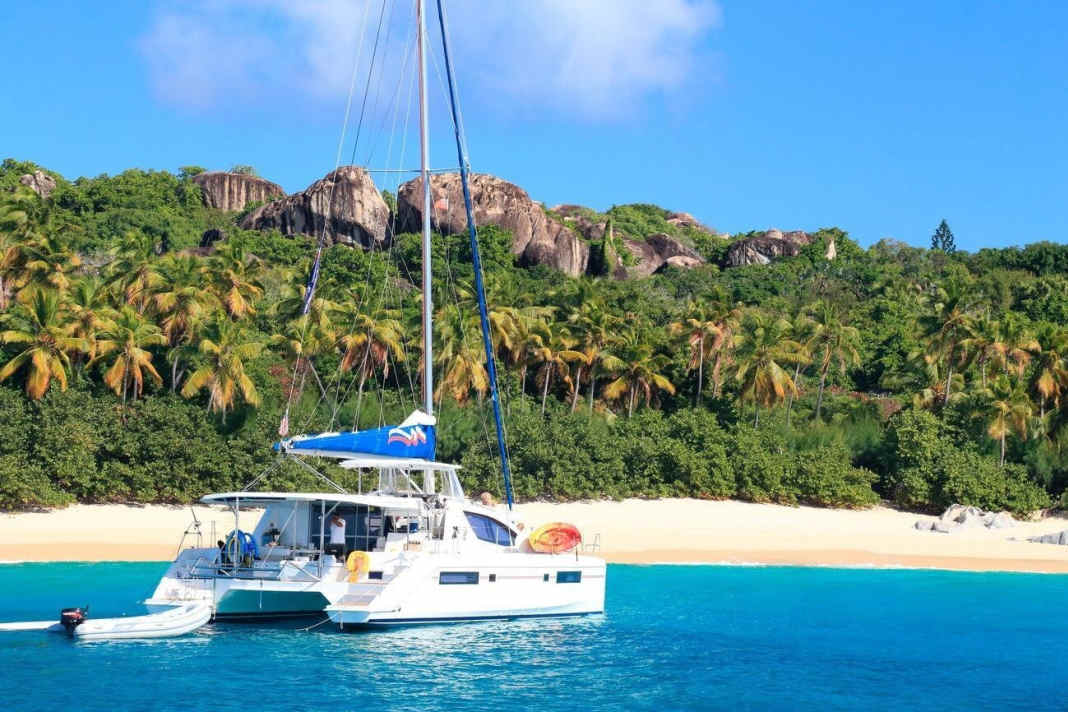
ARRIVAL

The main island of Tortola cannot be reached by direct flights from Germany, so crews have three transfer options: Either to St Martin, usually via Paris (without changing airports!) with Air France or alternatively with KLM via Amsterdam. Then continue to Tortola with the island hopper. The third option is to fly to Puerto Rico and then change planes there. The advantage is that this is possible from Germany. However, the route also has a major disadvantage: Puerto Rico is part of the USA, so you have to apply for an e-visa, and as Puerto Rico does not have an international transfer terminal, there is no choice but to enter the country, including time-consuming US border formalities and collecting your own luggage. The crew then have to change terminals, check in their luggage again and go through the US security checks. A time-consuming procedure. The destination of St Martin is much quicker.
CHARTER
All charter stations are located on Tortola: Road Harbour, Hodges Creek, Sopers Hole, Maya Cove - all are just a few kilometres apart and can be reached in around 30 minutes by taxi. There is plenty on offer. As is almost always the case in the Caribbean, cats are now clearly in the majority, but there is also a good selection of monohulls. The price level in the BVI is somewhat higher than in the more southerly areas of the Caribbean, as the manageable and well-protected area is the favourite destination of all crews.
It is no longer advisable to sail over to the St. Martin area (just under 80 miles), which until a few years ago crews with an appetite for long trips would do if their favourite boat in the area was fully booked. As the BVI introduced a high tax for charter yachts from other regions in 2017 (16 US dollars per day and person), it is almost never worth the effort.

WIND & WEATHER
The best time to visit is from the end of the hurricane season at the end of November until April. During this time, a fairly constant trade wind blows from the east to north-east, usually at 12 to 25 knots, along the Sir Francis Drake Channel. Until mid-December, the weather is somewhat less stable than during the rest of the sailing season. From April to June there tends to be less wind. In December and January, the so-called Christmas winds can occur, which can be somewhat stronger and then also come from northerly directions. They are associated with the passage of dense clouds and heavy showers from this direction and are heralded by a sharp drop in air pressure.
Crews in tropical areas must always be prepared for sudden showers or thunderstorms with corresponding gusts, but these do not last long.
Most crews obtain weather reports via the usual apps such as Windy or Windfinder Pro. In the French areas you are in EU roaming. It can be more expensive off other islands, and many crews then use WiFi networks in bars or restaurants.






The hurricane season officially runs from 1 June to 30 November.
NAVIGATION & SEAFARING
The BVI is rightly considered the easiest Caribbean sailing area. The waters in the Sir Francis Drake Channel between Tortola and the smaller islands off the coast offer protection from the swell of the Atlantic and too much wind. The distances are very short, the next good spot can always be reached in an hour or two.
The area is relatively well buoyed and not too challenging to navigate, with only a few difficult approaches, such as the fairway to Anegada, Savanna Bay on Virgin Gorda or similar, which tends to silt up. When approaching such anchorages, crews have to rely on "eyeball navigation", i.e. navigating by sight, because of the reef heads. This works according to the colour of the water. Deep water is blue, green or turquoise water is around five to eight metres deep, brown and grey water indicates rocks or coral heads. It is also important that this is not possible against the sun, which may even be low in the sky. Accordingly, the approach must be planned according to the time of day.
When approaching harbours and fairways, please note that the lateral marking system in the Caribbean is the reverse of the European system (IALA-B): When entering the fairway from the sea, there are red buoys on the starboard side instead of green ones.
Most charter companies prohibit sailing in the dark. You should therefore make sure that you reach the harbour or anchorage by around five or even four o'clock. Exceptions are possible on request. In some cases, however, large distances from the shore must be maintained.
HARBOURS & ANCHORAGES
Most of the time, crews will moor at buoys, as many bays have buoy fields and anchoring between them is almost always prohibited. A night at the buoys costs around 30 US dollars, the most common form of payment in the area. The fee is either collected by employees in boats or sometimes the skipper has to pay it on the beach in a bar or restaurant. Often there are also jetties for the dinghies.
LITERATURE & NAUTICAL CHARTS
"Cruising Guide to the Virgin Islands" by N. and S. Scott, approx. 40 euros, available from specialised dealers (e.g. Hansenautic). Very good are the nautical charts and the Cruising Guide from NV-Verlag, set 12.1 "Virgin Islands" and "Cruising Guide Virgin Islands", 89 and 29.80 euros respectively.
TERRITORY CHARACTERISTICS
The northernmost charter destination in the Caribbean combines many superlatives: it offers beautiful beaches in bays with palm trees and quaint beach bars, crystal-clear turquoise water, perfect infrastructure and sheltered sailing. No wonder the Virgin Islands are the favourite destination of German charter crews. If you don't fancy long 20 or 30-mile journeys to the next island in the trade winds and swell and don't want the hassle of clearing in and out, then this is the place for you, as you always stay in BVI waters. Hardly any crew make the time-consuming change to the US Virgin Islands. Rarely do you sail for more than a few hours; many crews focus on relaxing, swimming and snorkelling and then spending the evening on the beach in restaurants or bars.
There are no pushy boat boys like in the Grenadines and virtually no crime. The islands are famous for their quaint bars and parties, for example "Foxy's" on Jost van Dyke or the Full Moon Party in Trellis Bay. For those who like it a little rougher, "Bombas Shack" and the party ship "Willy T" off Norman Island are just the thing. The BVI stands for carefree Caribbean fun against a marvellous backdrop, ideal for Caribbean newcomers. The crews meet for happy hour at the bars on the beach, you can immediately strike up a conversation with sailors from all over the world and then head to one of the lovely restaurants on the beach for a meal or barbecue. The sailing area is easy from a nautical point of view, sailing is almost always on sight and there are only a few tricky reef passages.
However, this also means that the Virgin Islands are correspondingly busy. In the high season, the buoy fields and anchorages are quickly occupied, you are never alone, and if you arrive at popular spots such as Cooper Island or The Baths after 1 pm, you hardly have a chance of finding a mooring. The prices for yachts here are also slightly higher than at other destinations. In general, the price level in the Caribbean is significantly higher than in Europe, and culinary delights are often better further south on the French islands.
If you sail here for 10 to 14 days, you can easily sail the whole area, including the only long beat out to the shallow coral island of Anegada. But crews also come for just one week - the BVI is the only area where this is really still possible. If you like it sporty, you can come to the BVI Spring Regatta, but the cult Caribbean regattas can be found further south in the area.

